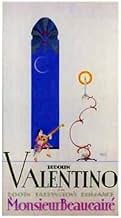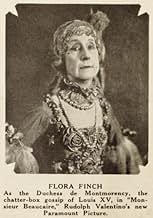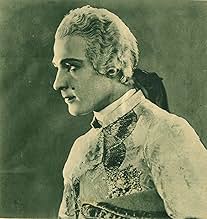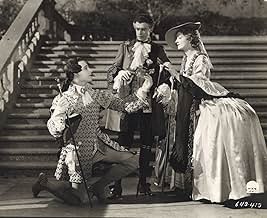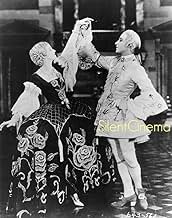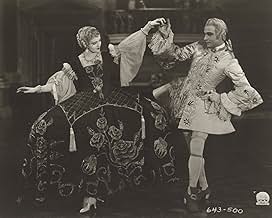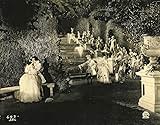Ajouter une intrigue dans votre langueWhen M. Beaucaire, a handsome barber, catches the Duke of Winterset cheating at gambling, Beaucaire exacts Winterset's cooperation in sneaking Beaucaire into a great ball, disguised as the D... Tout lireWhen M. Beaucaire, a handsome barber, catches the Duke of Winterset cheating at gambling, Beaucaire exacts Winterset's cooperation in sneaking Beaucaire into a great ball, disguised as the Duke de Chartres, and to introduce him to the beautiful Lady Mary. The disguised barber suc... Tout lireWhen M. Beaucaire, a handsome barber, catches the Duke of Winterset cheating at gambling, Beaucaire exacts Winterset's cooperation in sneaking Beaucaire into a great ball, disguised as the Duke de Chartres, and to introduce him to the beautiful Lady Mary. The disguised barber successfully pulls off the masquerade and is soon the toast of society. But Winterset is embi... Tout lire
- Prix
- 3 victoires au total
Avis en vedette
That said, it can't be denied that much of the film, particularly the beginning, is slow moving and static: sumptuous costumes and sets seem to have replaced dramatic action (The Sheik may have been inauthentic and schlocky, but at least it moved). I believe the film also suffers from its lack of a strong, or at least charismatic and likable leading lady for Valentino to spar with and courta serious flaw in a romance. Princess Henriette (Bebe Daniels has been far more appealing elsewhere) and Lady Mary are virtually indistinguishable: spoiled and sullen, they recall the upper class fiancé Valentino was only too happy to be rid of in "Moran of the Lady Letty" far more than the memorable female leads of "The Four Horsemen of the Apocalypse," "Blood and Sand," "The Eagle" and the sheik movies.
Not an unmitigated disaster by any means, but Valentino has certainly done better work elsewhere.
After a two year strike, Rudolph Valentino made "Monsieur Beaucaire" his comeback film. It's an elaborate, confusing, and mannered production. Nevertheless, in Valentino's case, absence did make the hearts of America grow fonder; and, Valentino spent the next two years as the USA's top male Box Office Star. Probably, the position was enhanced due to the continued circulation of the star's previous hits.
"Monsieur Beaucaire" is a valiant failure. Staid, light and shadow direction by Sidney Olcott, daintily made-up and costumed players, and elaborately designed scenes are featured. The story of a royal assuming the commoner's role is interesting; but, despite the title, Valentino is only briefly seen in the entertaining role of barber. Possibly, the film's focus was lost during the making.
One of Valentino's 1923 song recordings was added to the soundtrack; listen for it when the star sings a serenade, near the film's beginning. A record wasn't released until later, but the song is chronologically correct, herein; thematically, the Valentino recordings more closely fit other films, however. This recording, and Valentino's successful American tour, suggested a Garbo-like success in talking films was possible, had Valentino lived into the sound era.
***** Monsieur Beaucaire (8/11/24) Sidney Olcott ~ Rudolph Valentino, Bebe Daniels, Lois Wilson
Certainly the director could have led the story/play by Booth Tarkington through better contrived scenes where the actors portrayed more interesting situations. Often, they stood in position as if asking "What comes next" They may have well just butted their heads together. It was out of whack in a way hard to describe.
Might another director pulled it off? Maybe. Nazamova knew how to weave a story before your eyes. (I am thinking of Camille) I feel the male actors held up their end of the action. The women were insipid. Valentino was very good. Three cheers, he brought it off. I liked the movie despite my criticism.
Director Sidney Olcott was a film pioneer whose directing career dated back to 1907. His best remembered work is From the Manger to the Cross, a film on the life of Christ which was produced in Palestine in 1912 near the original locations. That early feature survives and holds up remarkably well today, but it appears that by the mid-1920s Olcott's cinematic skill was falling behind that of more innovative directors. Unfortunately, Monsieur Beaucaire looks stodgy and old-fashioned compared to concurrent works by rising talents such as Ernst Lubitsch. (Lubitsch had already demonstrated by this time that costume pictures can be stylish, sexy and fun.) Olcott makes a rather half-hearted attempt to be 'modern' in his staging of the first sword-fight sequence, when he limits the camera's viewpoint to a bystander's facial reaction while showing only the tips of the fighter's swords in the foreground, but the effect is gimmicky and unsatisfying: we don't want tricky camera angles, we want to see what's happening! The second fight sequence is a considerable improvement, and also reveals that, fancy duds notwithstanding, Valentino could handle swordplay. During this second sequence Olcott breaks down the fourth wall for a moment as Rudy lunges directly at the camera. Otherwise, however, the directorial approach is uninspired.
Perhaps the biggest problem here is clutter: there are too many title cards, the cards themselves are too wordy, and too many supporting characters are introduced who have little or nothing to do with the central plot. For all the unnecessary embellishments the story is a fairly straightforward one: Valentino is the Duke of Chartres, a member of the King's court and a royal favorite. He's interested in Princess Henriette (Bebe Daniels), but she's put off by his reputation and his closeness to the King's mistress. After defying a direct order from the King to marry Henriette, the Duke finds it expedient to flee the court for England. In Bath he assumes the identity of a humble barber. He becomes intrigued with Lady Mary, the Belle of Bath (Doris Kenyon), but she's put off by his lowly status. (It's always something!) Eventually, he returns to the French court and to Henriette, newly appreciative that she loves him for himself. That's the gist of it, but the screenwriters who adapted Tarkington's novel failed to streamline the story for the requirements of silent cinema, and Olcott lacked Lubitsch's facility for conveying plot points with witty visual ideas. The first section in the French court is especially draggy, but the tempo improves once Rudy reaches England and assumes his barber disguise. Eventually the story becomes more engaging, but over all the film falls short of the cinematic treat it could have been.
Valentino carries the proceedings with his undeniable charisma, but the numerous supporting players have little to do except pose in their fancy costumes; even such estimable talents as Bebe Daniels and Lowell Sherman are reduced to brief moments, while other characters register only as dress extras. It's a particular shame that Bebe's character is so relentlessly serious, since she had such a gift for comedy, and more humor would have given this production a boost. Monsieur Beaucaire has never had a very high reputation among silent film buffs, in part perhaps because it compares poorly to the two costume dramas Rudy made in the last year of his life, The Eagle and The Son of the Shiek, both of which were crafted with so much more flair and playful humor. Interestingly, when Monsieur Beaucaire itself was remade in the 1940s it was reworked as an outright comedy, and Valentino's role was assigned to the most unlikely successor imaginable: Bob Hope!
Le saviez-vous
- AnecdotesBebe Daniels later recalled that the cast was required to recite all their dialog in French.
- ConnexionsFeatured in Blue Skies (1946)
Meilleurs choix
Détails
Box-office
- Brut – États-Unis et Canada
- 556 826 $ US
- Durée
- 1h 46m(106 min)
- Mixage
- Rapport de forme
- 1.33 : 1

